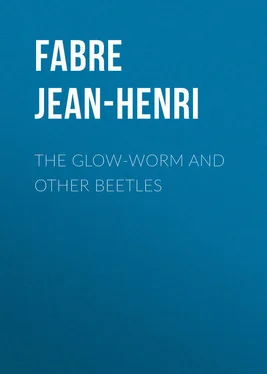Jean-Henri Fabre - The Glow-Worm and Other Beetles
Здесь есть возможность читать онлайн «Jean-Henri Fabre - The Glow-Worm and Other Beetles» — ознакомительный отрывок электронной книги совершенно бесплатно, а после прочтения отрывка купить полную версию. В некоторых случаях можно слушать аудио, скачать через торрент в формате fb2 и присутствует краткое содержание. Жанр: foreign_antique, foreign_prose, на английском языке. Описание произведения, (предисловие) а так же отзывы посетителей доступны на портале библиотеки ЛибКат.
- Название:The Glow-Worm and Other Beetles
- Автор:
- Жанр:
- Год:неизвестен
- ISBN:нет данных
- Рейтинг книги:5 / 5. Голосов: 1
-
Избранное:Добавить в избранное
- Отзывы:
-
Ваша оценка:
- 100
- 1
- 2
- 3
- 4
- 5
The Glow-Worm and Other Beetles: краткое содержание, описание и аннотация
Предлагаем к чтению аннотацию, описание, краткое содержание или предисловие (зависит от того, что написал сам автор книги «The Glow-Worm and Other Beetles»). Если вы не нашли необходимую информацию о книге — напишите в комментариях, мы постараемся отыскать её.
The Glow-Worm and Other Beetles — читать онлайн ознакомительный отрывок
Ниже представлен текст книги, разбитый по страницам. Система сохранения места последней прочитанной страницы, позволяет с удобством читать онлайн бесплатно книгу «The Glow-Worm and Other Beetles», без необходимости каждый раз заново искать на чём Вы остановились. Поставьте закладку, и сможете в любой момент перейти на страницу, на которой закончили чтение.
Интервал:
Закладка:
When and how did it get in? In none of the cells where I have observed it was I able to distinguish a fissure which could have allowed it to enter; they are all sealed in a quite irreproachable manner. The parasite therefore established itself in the honey-warehouse before the warehouse was closed; on the other hand, the open cells, full of honey, but as yet without the egg of the Anthophora, are always free from parasites. It is therefore during the laying, or afterwards, when the Anthophora is occupied in plastering the door of the cell, that the young larva gains admittance. It is impossible to decide by experiment to which of these two periods we must ascribe the introduction of the Sitares into the cell; for, however peaceable the Anthophora may be, it is evident that we cannot hope to witness what happens in the cell at the moment when she is laying an egg or at the moment when she is making the lid. But a few attempts will soon convince us that the only second which would allow the Sitaris to establish itself in the home of the Bee is the very second when the egg is laid on the surface of the honey.
Let us take an Anthophora-cell full of honey and furnished with an egg and, after removing the lid, place it in a glass tube with a few Sitaris-grubs. The grubs do not appear at all eager for this wealth of nectar placed within their reach; they wander at random about the tube, run about the outside of the cell, sometimes happen upon the edge of the orifice and very rarely venture inside. When they do, they do not go far in and they come out again at once. If one happens to reach the honey, which only half fills the cell, it tries to escape as soon as it has perceived the shifting nature of the sticky soil upon which it was about to enter; but, tottering at every step, because of the viscous matter clinging to its feet, it often ends by falling back into the honey, where it dies of suffocation.
Again, we may experiment as follows: having prepared a cell as before, we place a larva most carefully on its inner wall, or else on the surface of the food itself. In the first case, the larva hastens to leave the cell; in the second case, it struggles awhile on the surface of the honey and ends by getting so completely caught that, after a thousand efforts to gain the shore, it is swallowed up in the viscous lake.
In short, all attempts to establish the Sitaris-grub in an Anthophora-cell provisioned with honey and furnished with an egg are no more successful than those which I made with cells whose store of food had already been broached by the larva of the Bee, as described above. It is therefore certain that the Sitaris-grub does not leave the fleece of the Mason-bee when the Bee is in her cell or at the entrance to it, in order itself to make a rush for the coveted honey; for this honey would inevitably cause its death, if it happened by accident to touch the perilous surface merely with the tip of its tarsi.
Since we cannot admit that the Sitaris-grub leaves the furry corselet of its hostess to slip unseen into the cell, whose orifice is not yet wholly walled up, at the moment when the Anthophora is building her door, all that remains to investigate is the second at which the egg is being laid. Remember in the first place that the young Sitaris which we find in a closed cell is always placed on the egg of the Bee. We shall see in a minute that this egg not merely serves as a raft for the tiny creature floating on a very treacherous lake, but also constitutes the first and indispensable part of its diet. To get at this egg, situated in the centre of the lake of honey, to reach, at all costs, this raft, which is also its first ration, the young larva evidently possesses some means of avoiding the fatal contact of the honey; and this means can be provided only by the actions of the Bee herself.
In the second place, observations repeated ad nauseam have shown me that at no period do we find in each invaded cell more than a single Sitaris, in one or other of the forms which it successively assumes. Yet there are several young larvæ established in the silky tangle of the Bee's thorax, all eagerly watching for the propitious moment at which to enter the dwelling in which they are to continue their development. How then does it happen that these larvæ, goaded by such an appetite as one would expect after seven or eight months' complete abstinence, instead of all rushing together into the first cell within reach, on the contrary enter the various cells which the Bee is provisioning one at a time and in perfect order? Some action must take place here independent of the Sitares.
To satisfy those two indispensable conditions, the arrival of the larva upon the egg without crossing the honey and the introduction of a single larva among all those waiting in the fleece of the Bee, there can be only one explanation, which is to suppose that, at the moment when the Anthophora's egg is half out of the oviduct, one of the Sitares which have hastened from the thorax to the tip of the abdomen, one more highly favoured by its position, instantly settles upon the egg, a bridge too narrow for two, and with it reaches the surface of the honey. The impossibility of otherwise fulfilling the two conditions which I have stated gives to the explanation which I am offering a degree of certainty almost equivalent to that which would be furnished by direct observation, which is here, unfortunately, impracticable. This presupposes, it is true, in the microscopic little creature destined to live in a place where so many dangers threaten it from the first, an astonishingly rational inspiration, which adapts the means to the end with amazing logic. But is not this the invariable conclusion to which the study of instinct always leads us?
When dropping her egg upon the honey, therefore, the Anthophora at the same time deposits in her cell the mortal enemy of her race; she carefully plasters the lid which closes the entrance to the cell; and all is done. A second cell is built beside it, probably to suffer the same fatal doom; and so on until the more or less numerous parasites sheltered by her down are all accommodated. Let us leave the unhappy mother to continue her fruitless task and turn our attention to the young larva which has so adroitly secured itself board and lodging.
In opening cells whose lid is still moist, we end by discovering one in which the egg, recently laid, supports a young Sitaris. This egg is intact and in irreproachable condition. But now the work of devastation begins: the larva, a tiny black speck which we see running over the white surface of the egg, at last stops and balances itself firmly on its six legs; then, seizing the delicate skin of the egg with the sharp hooks of its mandibles, it tugs at it violently until it breaks, spilling its contents, which the larva eagerly drinks up. Thus the first stroke of the mandibles which the parasite delivers in the usurped cell is aimed at the destruction of the Bee's egg. A highly logical precaution! The Sitaris-larva, as we shall see, has to feed upon the honey in the cell; the Anthophora-larva which would proceed from that egg would require the same food; but the portion is too small for two; so, quick, a bite at the egg and the difficulty will be removed. The story of these facts calls for no comment. This destruction of the cumbersome egg is all the more inevitable inasmuch as special tastes compel the young Sitaris-grub to make its first meals of it. Indeed we see the tiny creature begin by greedily drinking the juices which the torn wrapper of the egg allows to escape; and for several days it may be observed, at one time motionless on this envelope, in which it rummages at intervals with its head, at others running over it from end to end to rip it open still wider and to cause a little of the juices, which become daily less abundant, to trickle from it; but we never catch it imbibing the honey which surrounds it on every side.
Читать дальшеИнтервал:
Закладка:
Похожие книги на «The Glow-Worm and Other Beetles»
Представляем Вашему вниманию похожие книги на «The Glow-Worm and Other Beetles» списком для выбора. Мы отобрали схожую по названию и смыслу литературу в надежде предоставить читателям больше вариантов отыскать новые, интересные, ещё непрочитанные произведения.
Обсуждение, отзывы о книге «The Glow-Worm and Other Beetles» и просто собственные мнения читателей. Оставьте ваши комментарии, напишите, что Вы думаете о произведении, его смысле или главных героях. Укажите что конкретно понравилось, а что нет, и почему Вы так считаете.












